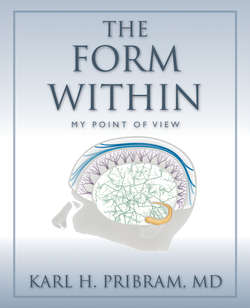Читать книгу The Form Within - Karl H Pribram - Страница 6
На сайте Литреса книга снята с продажи.
Prologue The Quest
ОглавлениеWhen Clerk-Maxwell was a child it is written that he had a mania for having everything explained to him, and that when people put him off with vague verbal accounts of any phenomenon he would interrupt them impatiently by saying, ‘Yes; but I want to know the particular go of it!’ Had the question been about truth, only a pragmatist could have told him the particular go of it. . . . Truths emerge from facts; but they dip forward into facts again and add to them; which facts again create or reveal new truth. . . . And so on indefinitely. The facts themselves are not true. They simply are. Truth is the function of beliefs that start and terminate among them.
—William James, Pragmatism: A New Name for Some Old Ways of Thinking, 1931
Have you noticed the massive interest shown by the scientific community in studies of mind and brain? Scientific American is publishing a new journal, Mind; Psychology Today is headlining studies of the workings of the brain; Popular Science and Discover are filled with tales of new discoveries that relate mind to brain and 37,000 neuroscientists are working diligently to make these discoveries possible.
It has not always been this way. When, as an undergraduate at the University of Chicago in the 1930s, I took a course on the nervous system, we stopped short of the brain cortex—and what we now know as the “limbic systems” was dismissed as a most mysterious territory called the “olfactory brain.”
It was this very lack of knowledge that attracted me: The Form Within is the story of my adventures in charting this most important world about which we then knew so little. In the process, the data I gathered and the colleagues with whom I worked changed what opinions I had brought to the research and added sophistication to my interpretations. In retrospect what impresses me—and what I urge my students to appreciate—is the long time required, sometimes decades of passion, persistence and patience, for an idea to ripen into a body of hard evidence and a theoretical formulation that I was finally able to communicate clearly to others.
The Form Within tells the story of my voyage of discovery during almost a century of research and theory construction. The story is set within the frame of the discoveries of the previous century, the 19th, which totally revised our understanding in the Western world of how our brains work. During the 17th century and earlier, the human brain was thought to process air, often termed “spirits.” With the advent of the sciences of chemistry and of electricity, a basic understanding of brain processes was attained that, to a large extent, resembles our current views. Writings like those of William James and Sigmund Freud, around the juncture of the two centuries, will be referenced repeatedly in the following chapters.
My own story has a somewhat different perspective from that which is currently available in most neuro- and psychological science books and journals. For example, my interactions with the 20th century “shapers of viewpoints” in the brain and behavioral sciences—B.F. Skinner and Karl Lashley, experimental psychologists; Wilder Penfield, neurosurgeon; Arthur Koestler, author; John Eccles, neurophysiologist and Karl Popper, philosopher—expose the questions that puzzled us rather than the dogma that has become associated with their names.
Thus, The Form Within is the story of my quest. It charts a voyage of discovery through 70 years of breakthroughs in brain and psychological research. More than a hundred students have obtained their doctoral and postdoctoral training in my laboratory and gone on to productive and in some cases outstanding careers. Collaboration with scientists on five continents has formed and continues to form my views. The voyage is not over: each month I’ve had to add to, and in some cases revise, this manuscript. But as a work in progress, The Form Within is to me an inspiring chronicle of a most exciting voyage through what, often, at the time, has seemed to be a storm of experimental and theoretical findings. As you will see, the concept of form—the form within as formative causation—provides a novel and safe vessel for this journey.
